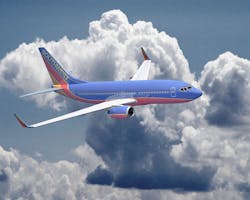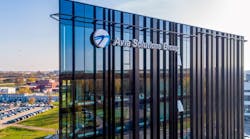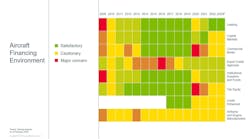March 04--Boeing calls the odd-looking upturned wingtips on aircraft "blended winglets," Airbus calls them "sharklets" and Southwest Airlines, in ads, simply calls them "little DooHickeys."
Whatever the name, these wingtip extensions have become prevalent in recent years and have saved airlines billions of dollars in fuel costs. The newest, and funkiest-looking, version was used on a United Airlines commercial flight for the first time last month. The new design features the upturned wingtip but adds a downward-facing sword and sinister-looking pointed tips, which together make it a "split scimitar winglet."
Winglets might look cool and represent one of the more radical changes to the appearance of modern jets, but in truth, they're all business.
While winglets could cost $1 million or more per aircraft to install and add several hundred pounds to an aircraft, they pay for themselves in a few years through fuel savings -- about 4 percent savings for the blended winglet and an additional 2 percent savings for the split scimitar.
For airlines, adding the 8-foot-tall blended winglets has become a no-brainer, and adding the split scimitar version also seems to be.
"We have the philosophy: Put them on everything that we can," said Ron Baur, fleet vice president at Chicago-based United Airlines. "Anything we can do to save fuel, we're all over it. ...They're a huge deal for us."
Winglets reduce drag and increase lift at the end of the wings, where the physics of flight create small tornadoes. Winglets essentially reduce the size of those whirling air masses and improve the plane's "gas mileage" by helping jets more efficiently slice through the sky.
Savings of 4 percent and 2 percent might not sound like much, but consider that United uses 4 billion gallons of fuel in a year, or 1 percent of the world's annual oil supply. And consider that jet fuel prices have soared during the past 15 years, to $3 per gallon today from about 50 cents per gallon.
A single set of scimitar winglets on one plane at United saves about 45,000 gallons of jet fuel in a year, the airline said. For perspective, that's as many gallons of gasoline as an average car would use in 72 years -- more than an average person would use in a lifetime of regular fill-ups.
United expects the new and older wingtip designs on its 737, 757 and 767 fleets to annually save it 65 million gallons of fuel, $200 million worth, and the equivalent of 645,000 metric tons of carbon dioxide emissions.
"Fuel is our biggest expense and our most volatile expense," Baur said. "Anything that has a savings due to fuel efficiency is one of our top priorities."
A different case in point: United's new Boeing 737s have slightly modified anti-collision lights that reduce drag and improve fuel efficiency by just a few tenths of a percent.
"We chase very small percentages," Baur said.
That why winglets are suddenly so important, and why airlines have been rushing to order winglets on new planes and add them to existing aircraft.
About 7,000 blended winglet systems have been sold, the majority of which are in service with more than 200 airlines in more than 100 countries, according to Aviation Partners Boeing, a Seattle-based Boeing joint-venture company that sells the winglets for Boeing aircraft.
Last fall, Southwest Airlines, the largest carrier at Midway Airport, touted its winglets in an ad campaign, calling them doohickeys and noting they save the airline 54 million gallons of fuel each year and reduce emissions. The airline says it's one way it is trying to keep fares low.
The version of winglets for Airbus planes, called sharklets, has been available relatively recently as a retrofit for existing aircraft, but they will be a standard feature on the latest A320neo series, due to start flying in 2015.
Perhaps not surprising because Airbus and Boeing are bitter rivals in the aircraft sales business, Airbus and Aviation Partners Boeing are in a patent dispute about the wingtips.
Besides United, another Chicago-area beneficiary of the winglet craze is AAR Corp., headquartered in Wood Dale near O'Hare International Airport. It is among the aviation maintenance companies installing winglets on existing aircraft.
Business has been booming.
AAR has installed blended winglets on about 250 aircraft in recent years and will start installing the split scimitar winglets this month, said Chris Jessup, AAR senior vice president of airframe and engineering services.
"They're very popular," he said. "It's additional work, above and beyond the normal work that we do."
Winglet installations alone are likely to account for 10 percent of revenue in AAR's maintenance and repair division, Jessup said.
Adding winglets is not simply about bolting on the extensions. The aircraft's wing must be reinforced to handle the additional weight. And a blended winglet requires substantial strengthening before converting it to a split scimitar.
But the significant upgrade is worth it because the business case for winglets is so strong, with payback in about 2 1/2 years, Jessup said. In fact, some airlines don't wait until the typical maintenance schedule to install them, but make special arrangements to get their planes through the retrofit process, he said.
"It's tangible savings they can realize from day one," he said.
The idea of winglets isn't particularly new. Even grade school paper airplane-makers know it helps to fold up the tips of the wings to make the plane fly farther.
The modern winglet traces its roots to NASA research in the 1970s aimed at reducing aviation fuel use during the oil crisis early in the decade.
Aviation Partners Boeing, formed in 1999, first created its version of winglets to help business jets fly farther without refueling.
A decade ago, Continental Airlines, now merged into United, got involved with blended winglets because it wanted to fly its Boeing 757-200 airplanes farther -- from Newark, N.J., nonstop to mainland Europe instead of just to the United Kingdom and Ireland.
It could put more fuel tanks on airplanes or find a way to burn less fuel. Winglets were the more elegant solution, allowing the airline to burn less fuel and allowing planes to fly farther, making Continental the first major network carrier in the U.S. to use blended winglets on a commercial jet.
Winglets can also reduce maintenance costs, improve takeoff performance and fetch higher resale values for planes that have them, in addition to other benefits, according to Aviation Partners Boeing.
But recently, the dramatic rise in jet fuel prices has led to winglet ubiquity.
"Fuel's gone up so much, so fast, that now it's all about fuel savings," said Patrick Lamoria, spokesman for Aviation Partners Boeing. "That's why it's become so popular."
Aviation Partners Boeing's new split scimitar winglet, a modification of its blended winglet design that further improves an aircraft's lift, has been especially popular.
Aviation Partners Boeing has taken orders and options for 1,461 of the new winglet design, which measures nearly 12 feet from top to bottom.
United was the first U.S. airline to use the split scimitar, during a Feb. 18 commercial flight from Houston to Los Angeles, only a couple of weeks after it was certified by the Federal Aviation Administration for use on Boeing 737-800 aircraft.
United plans to start adding many more this month, and passengers are likely to see them on some flights through Chicago this year, Baur said.
"Because of the savings, we want to do it as fast as we can," he said.
Copyright 2014 - Chicago Tribune


